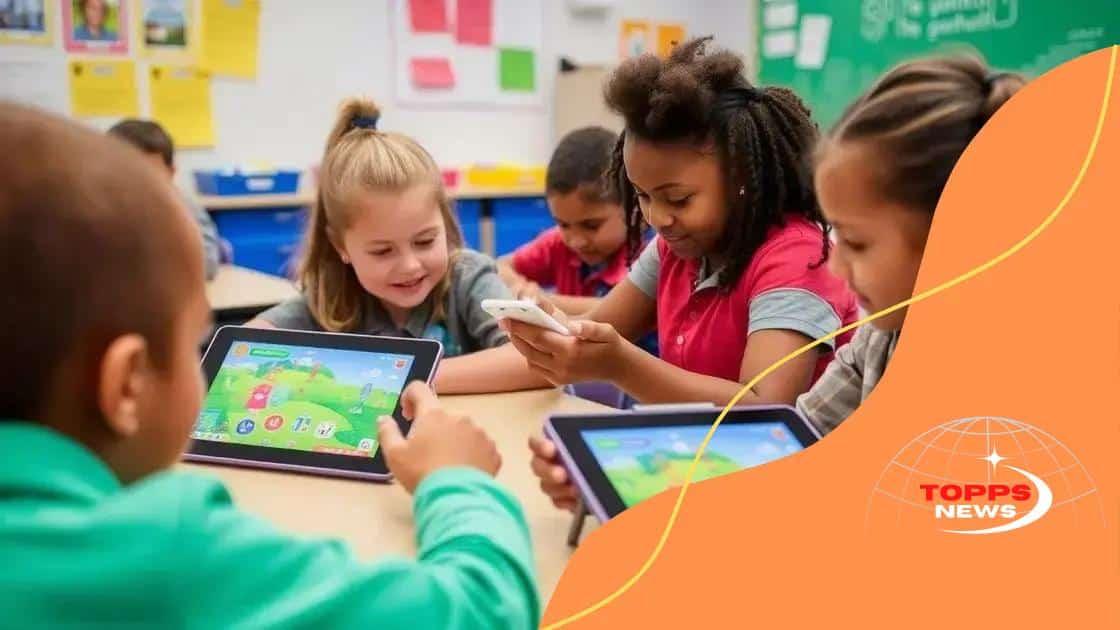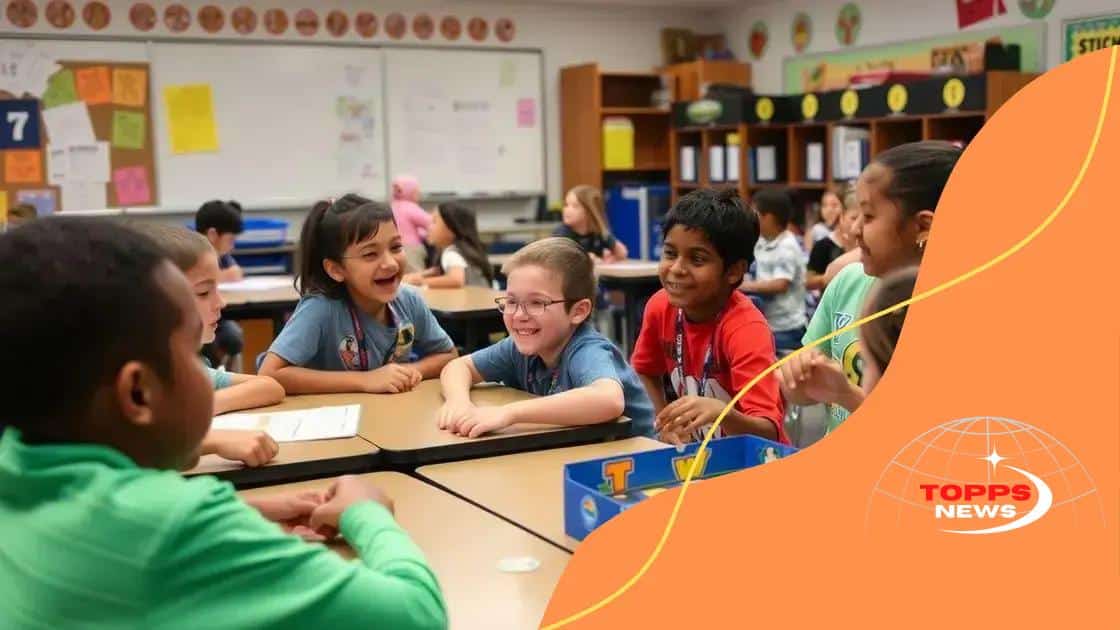Gamified learning in K-12 education: engaging students effectively

Gamified learning in K-12 education enhances student engagement, improves knowledge retention, and fosters essential social skills through interactive and immersive experiences, utilizing technologies such as virtual reality and personalized learning paths.
Gamified learning in K-12 education offers an innovative way to captivate young minds. Imagine turning lessons into thrilling games that spark joy and curiosity! How does this approach transform the classroom experience? Let’s dive in.
Understanding the principles of gamified learning
Understanding the principles of gamified learning is key to successfully implementing this engaging educational approach. It transforms traditional learning into fun experiences, motivating students to participate actively.
Core Elements of Gamified Learning
Several components make up effective gamified learning. Here are the primary principles:
- Goals: Clearly defined objectives help students understand what they need to achieve.
- Feedback: Immediate and constructive feedback keeps learners informed about their progress.
- Challenges: Incorporating appropriate challenges ensures that students are constantly engaged without feeling overwhelmed.
- Rewards: Offering rewards motivates students and recognizes their achievements in a fun way.
By focusing on these elements, educators can create an environment where learning feels like a game rather than a chore. This approach not only boosts student engagement but also enhances their desire to learn.
Motivation through Competition
Another principle is fostering motivation through friendly competition. When students compete in a relaxed setting, it can lead to remarkable outcomes. Competitions can be structured in various ways:
- Team challenges that promote collaboration.
- Individual quests that allow personal exploration.
- Point systems to track achievements and standings.
Incorporating these principles can significantly change how students interact with their education. As they venture through lessons, they begin to see learning as an adventure to conquer, rather than just a subject to be studied. This sense of adventure is key to developing a lifelong love for learning.
Benefits of gamified approaches in K-12
Embracing gamified approaches in K-12 education brings exciting benefits that can greatly enhance the learning experience. These methods not only engage students more effectively but also foster a positive classroom environment.
Increased Engagement
One of the most significant advantages of gamified learning is its ability to boost student engagement. When lessons are transformed into games, students feel more motivated to participate. This increased engagement often leads to better academic performance.
- Interactive lessons keep students interested.
- Friendly competition encourages participation.
- Varied formats appeal to different learning styles.
As students compete and collaborate, they become more involved in their own learning journeys. The gamified format encourages them to explore subjects deeply and think critically.
Improved Retention and Understanding
Another benefit is improved retention. Studies show that when information is presented in a fun format, students remember it better. Gamification involves repetition and reinforcement, which can enhance understanding.
This approach allows students to practice skills in a safe setting, making mistakes part of the learning process. By navigating challenges, they secure a deeper understanding of the material.
Development of Social Skills
Incorporating gamified approaches also helps develop essential social skills. Working in teams for challenges encourages communication and collaboration among students. As they engage with their peers, they learn how to respect different opinions and work towards common goals.
- Teamwork fosters a sense of community.
- Collaboration enhances problem-solving abilities.
- Positive interactions build confidence.
Overall, these benefits create a more dynamic and effective learning environment, benefiting both students and teachers.
Practical examples of gamified learning

Understanding practical examples of gamified learning helps educators see how these concepts apply in real classrooms. There are several innovative ways teachers use gamification to enhance learning.
Role-Playing Games
One effective method is using role-playing games. In subjects like history or literature, students can assume different characters to explore stories or events. This immersive experience makes learning memorable and engaging.
- Students act out historical events.
- Literature comes alive through character exploration.
- Encourages critical thinking and empathy.
By stepping into different roles, students develop a deeper understanding of the content.
Point Systems and Badges
Another example is implementing point systems and badges. Teachers can reward students for completing assignments, participating in class, or helping peers. These rewards foster motivation and can lead to friendly competition.
When students see their progress through points, they feel a sense of achievement. Badges serve as visual reminders of their hard work, further encouraging them to strive for more.
Educational Games
Incorporating educational games is another practical approach. Whether using board games or online platforms, games can make learning fun. For example, students can play math-related games that challenge their problem-solving skills while competing against classmates.
- Online platforms offer interactive learning experiences.
- Board games encourage teamwork and collaboration.
- Games can easily adapt to different subjects.
This hands-on approach makes concepts easier to grasp and allows for active participation.
Through these examples, it is clear that gamified learning can transform traditional education into exciting and effective experiences. Using various strategies allows educators to create engaging, interactive environments that foster a love of learning.
Challenges educators face with gamification
While gamification in education offers many benefits, educators also face several challenges. These obstacles can affect the successful implementation of gamified strategies in the classroom.
Resistance to Change
Many teachers may be hesitant to adopt new techniques like gamification. They might feel comfortable with traditional teaching methods and may resist changing their established routines. To overcome this, schools should provide training and resources.
- Offer professional development workshops.
- Share success stories from other educators.
- Encourage collaboration among teachers.
With proper support, teachers can gradually embrace gamified approaches, making the transition smoother.
Time Constraints
Another significant challenge is time. Developing gamified lessons can take more planning and preparation compared to traditional methods. Teachers often have limited time to create engaging activities while covering essential curriculum content.
Finding a balance between curriculum requirements and implementing gamification can be tough. Teachers may need to prioritize which aspects of their lessons can be gamified without overwhelming themselves.
Resource Limitations
Resource limitations also pose a challenge. Many schools do not have access to the necessary tools or technology to implement gamification effectively. This can include a lack of suitable software or digital platforms that facilitate gamified learning.
- Seek grants or funding opportunities.
- Utilize free online resources.
- Encourage community partnerships to gain support.
Educators can find creative solutions within their constraints to still provide engaging learning experiences.
Addressing these challenges is vital for maximizing the potential of gamified learning. As educators work through these obstacles, they can create effective, dynamic classrooms that inspire students.
Future of gamified learning in schools
The future of gamified learning in schools holds exciting possibilities that can reshape education. As technology advances, educators can access new tools that enhance the gamification experience.
Integration of Advanced Technology
In the coming years, schools will likely integrate more advanced technology into their classrooms. Virtual reality (VR) and augmented reality (AR) can create immersive learning experiences. These technologies allow students to explore subjects like science or history more vividly than ever before.
- VR can simulate historical events for a hands-on experience.
- AR can overlay information in real-world environments.
- Interactive simulations can deepen understanding of complex topics.
With these advancements, the gamified learning experience can become even more engaging and effective.
Personalized Learning Paths
Another trend in the future of gamified learning is personalized learning paths. As educators gather data on students’ progress and preferences, they can tailor gamified experiences to fit individual needs. This customization leads to greater student satisfaction and success.
If students can navigate content at their own pace, they are more likely to stay engaged. Teachers can use gamification to help students master topics that are challenging for them while allowing others to accelerate their learning.
Collaboration Beyond the Classroom
The future will also see increased collaboration among students from different schools and even countries. Online platforms can connect classrooms, allowing students to work together on gamified projects. This collaborative approach can help them develop essential skills, such as teamwork and communication.
- Global classrooms enhance cultural awareness.
- Collaborative projects foster innovation.
- Connecting students globally promotes empathy and understanding.
These factors highlight the potential of gamified learning to make education more relevant and inclusive, preparing students for future challenges.
The future of gamified learning in schools appears bright and filled with potential. As educators continue to overcome challenges, they can create engaging environments that captivate students. Implementing advanced technologies like VR and AR opens new pathways for immersive learning experiences. Personalizing education for each student ensures that everyone reaches their full potential. Moreover, working together with peers from different places fosters collaboration and global understanding. By embracing these changes, schools can prepare students for a successful future.
FAQ – Frequently Asked Questions about Gamified Learning in K-12 Education
What are the primary benefits of gamified learning?
Gamified learning increases student engagement, improves retention, and helps develop social skills by promoting collaboration and friendly competition.
How can technology enhance gamified learning?
Technology like virtual reality (VR) and augmented reality (AR) can create immersive experiences, making learning more engaging and interactive.
What challenges do educators face in implementing gamification?
Educators may encounter resistance to change, time constraints for lesson planning, and resource limitations that can affect effective gamification.
How will gamified learning evolve in the future?
The future of gamified learning includes personalized learning paths, increased collaboration among students from different schools, and the use of advanced technologies to enhance educational experiences.





